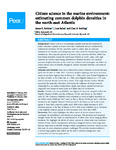Citizen science in the marine environment: estimating common dolphin densities in the north-east Atlantic
| dc.contributor.author | Robbins, JR | |
| dc.contributor.author | Babey, L | |
| dc.contributor.author | Embling, Clare | |
| dc.date.accessioned | 2021-01-05T22:39:16Z | |
| dc.date.issued | 2020-02-28 | |
| dc.identifier.issn | 2167-8359 | |
| dc.identifier.issn | 2167-8359 | |
| dc.identifier.other | e8335 | |
| dc.identifier.uri | http://hdl.handle.net/10026.1/16782 | |
| dc.description.abstract |
<jats:sec> <jats:title>Background</jats:title> <jats:p>Citizen science is increasingly popular and has the potential to collect extensive datasets at lower costs than traditional surveys conducted by professional scientists. Ferries have been used to collect data on cetacean populations for decades, providing long-term time series for monitoring of cetacean populations. One cetacean species of concern is the common dolphin, which has been found stranded around the north-east Atlantic in recent years, with high numbers on French coasts being attributed to fisheries bycatch. We estimate common dolphin densities in the north-east Atlantic and investigate the ability of citizen science data to identify changes in marine mammal densities and areas of importance.</jats:p> </jats:sec> <jats:sec> <jats:title>Materials and Methods</jats:title> <jats:p>Data were collected by citizen scientists on ferries between April and October in 2006–2017. Common dolphin sightings data from two ferry routes across three regions, Bay of Biscay (<jats:italic>n</jats:italic> = 569); south-west United Kingdom to the Isles of Scilly in the Celtic Sea (<jats:italic>n</jats:italic> = 260); and English Channel (<jats:italic>n</jats:italic> = 75), were used to estimate density across ferry routes. Two-stage Density Surface Models accounted for imperfect detection, and tested the influence of environmental (chlorophyll <jats:italic>a</jats:italic>, sea surface temperature, depth, and slope), spatial (latitude and longitude) and temporal terms (year and Julian day) on occurrence.</jats:p> </jats:sec> <jats:sec> <jats:title>Results</jats:title> <jats:p>Overall detection probability was highest in the areas sampled within the English Channel (0.384) and Bay of Biscay (0.348), and lowest on the Scilly’s route (0.158). Common dolphins were estimated to occur in higher densities on the Scilly’s route (0.400 per km<jats:sup>2</jats:sup>) and the Bay of Biscay (0.319 per km<jats:sup>2</jats:sup>), with low densities in the English Channel (0.025 per km<jats:sup>2</jats:sup>). Densities on the Scilly’s route appear to have been relatively stable since 2006 with a slight decrease in 2017. Densities peaked in the Bay of Biscay in 2013 with lower numbers since. Densities in the English Channel appear to have increased over time since 2009.</jats:p> </jats:sec> <jats:sec> <jats:title>Discussion</jats:title> <jats:p>This study highlights the effectiveness of citizen science data to investigate the distribution and density of cetaceans. The densities and temporal changes shown by this study are representative of those from wider-ranging robust estimates. We highlight the ability of citizen science to collect data over extensive periods of time which complements dedicated, designed surveys. Such long-term data are important to identify changes within a population; however, citizen science data may, in some situations, present challenges. We provide recommendations to ensure high-quality data which can be used to inform management and conservation of cetacean populations.</jats:p> </jats:sec> | |
| dc.format.extent | e8335-e8335 | |
| dc.format.medium | Electronic-eCollection | |
| dc.language | en | |
| dc.language.iso | en | |
| dc.publisher | PeerJ | |
| dc.subject | Citizen science | |
| dc.subject | Cetacean | |
| dc.subject | Platforms of opportunity | |
| dc.subject | Common dolphin | |
| dc.subject | Bycatch | |
| dc.subject | Distance sampling | |
| dc.subject | Density surface model | |
| dc.title | Citizen science in the marine environment: estimating common dolphin densities in the north-east Atlantic | |
| dc.type | journal-article | |
| dc.type | Journal Article | |
| plymouth.author-url | https://www.webofscience.com/api/gateway?GWVersion=2&SrcApp=PARTNER_APP&SrcAuth=LinksAMR&KeyUT=WOS:000517197700002&DestLinkType=FullRecord&DestApp=ALL_WOS&UsrCustomerID=11bb513d99f797142bcfeffcc58ea008 | |
| plymouth.issue | 0 | |
| plymouth.volume | 8 | |
| plymouth.publisher-url | https://peerj.com/articles/8335/ | |
| plymouth.publication-status | Published online | |
| plymouth.journal | PeerJ | |
| dc.identifier.doi | 10.7717/peerj.8335 | |
| plymouth.organisational-group | /Plymouth | |
| plymouth.organisational-group | /Plymouth/Faculty of Science and Engineering | |
| plymouth.organisational-group | /Plymouth/Faculty of Science and Engineering/School of Biological and Marine Sciences | |
| plymouth.organisational-group | /Plymouth/REF 2021 Researchers by UoA | |
| plymouth.organisational-group | /Plymouth/REF 2021 Researchers by UoA/UoA07 Earth Systems and Environmental Sciences | |
| plymouth.organisational-group | /Plymouth/Users by role | |
| plymouth.organisational-group | /Plymouth/Users by role/Academics | |
| dc.publisher.place | United States | |
| dcterms.dateAccepted | 2019-12-03 | |
| dc.rights.embargodate | 2021-1-7 | |
| dc.identifier.eissn | 2167-8359 | |
| dc.rights.embargoperiod | Not known | |
| rioxxterms.versionofrecord | 10.7717/peerj.8335 | |
| rioxxterms.licenseref.uri | http://www.rioxx.net/licenses/all-rights-reserved | |
| rioxxterms.licenseref.startdate | 2020-02-28 | |
| rioxxterms.type | Journal Article/Review |


